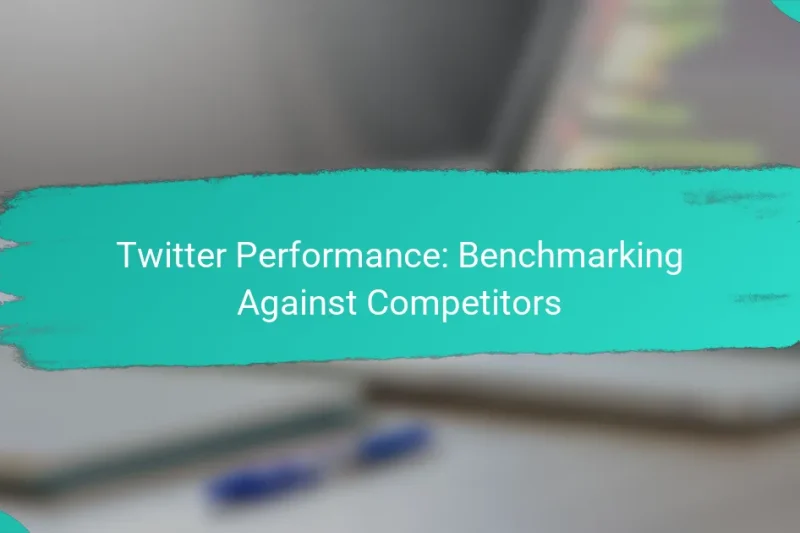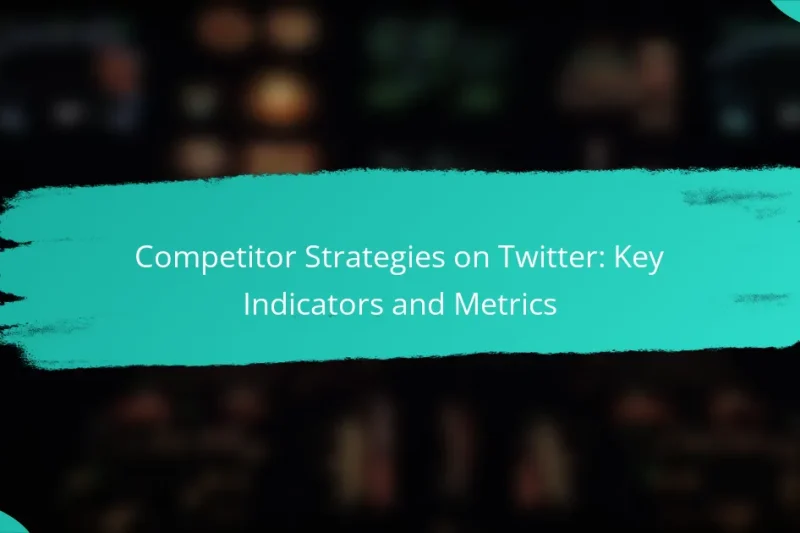Benchmarking Twitter performance against competitors is essential for understanding your brand’s position in the market. By … Twitter Performance: Benchmarking Against CompetitorsRead more
Competitor Analysis on Twitter
Competitor analysis on Twitter is essential for understanding the landscape of your industry and refining your own social media strategy. By examining key competitors’ follower demographics, engagement metrics, and content strategies, you can gain valuable insights that inform your approach. Utilizing specialized tools enhances this analysis, allowing you to track trends and optimize your performance for greater engagement and growth.
Competitor Strategies on Twitter: Key Indicators and Metrics
Analyzing competitor strategies on Twitter is essential for understanding market dynamics and improving your own social … Competitor Strategies on Twitter: Key Indicators and MetricsRead more
Twitter Brand Monitoring: Tools for Competitive Insights
Twitter brand monitoring is essential for gaining competitive insights, offering real-time data on brand perception and … Twitter Brand Monitoring: Tools for Competitive InsightsRead more
How to conduct competitor analysis on Twitter?
Conducting competitor analysis on Twitter involves identifying key competitors, analyzing their follower demographics, evaluating engagement metrics, assessing content strategies, and utilizing Twitter Analytics tools. This process helps you understand your competition and refine your own Twitter strategy for better engagement and growth.
Identify key competitors
Start by pinpointing the main competitors in your industry or niche. Look for brands that offer similar products or services and have a notable presence on Twitter. Tools like Twitter’s search function and third-party platforms can help you discover these accounts.
Once identified, create a list of these competitors to track their activities and strategies. This will provide a clear framework for your analysis and help you focus on the most relevant accounts.
Analyze follower demographics
Understanding the demographics of your competitors’ followers can provide insights into their target audience. Look for data on age, gender, location, and interests, which can often be found through Twitter Analytics or other social media analysis tools.
By comparing these demographics with your own audience, you can identify gaps or opportunities to better tailor your content and outreach efforts. This helps ensure that your messaging resonates with the right people.
Evaluate engagement metrics
Engagement metrics such as likes, retweets, and replies are crucial for assessing how well your competitors connect with their audience. Track these metrics over time to identify trends and peak engagement periods.
Consider calculating engagement rates by dividing the total interactions by the number of followers. This will give you a clearer picture of how effectively competitors engage their audience compared to your own performance.
Assess content strategies
Review the types of content your competitors share, including images, videos, polls, and links. Note which formats generate the most engagement and how often they post. This analysis can reveal successful content strategies that you might want to adopt or adapt.
Pay attention to the tone and style of their messaging as well. Understanding what resonates with their audience can inform your own content creation and help you differentiate your brand.
Utilize Twitter Analytics tools
Leverage Twitter Analytics and other third-party tools to gather data on your competitors. These tools can provide insights into follower growth, engagement rates, and content performance over time.
Some popular tools include Hootsuite, Sprout Social, and Followerwonk. Using these resources can streamline your analysis process and help you make data-driven decisions for your Twitter strategy.
What tools are best for Twitter competitor analysis?
Effective Twitter competitor analysis can be achieved using specialized tools that provide insights into social listening, content performance, and audience demographics. The right tools help identify trends, understand competitor strategies, and refine your own approach.
Hootsuite for social listening
Hootsuite excels in social listening, allowing users to monitor brand mentions, competitor activities, and industry trends on Twitter. By setting up streams for specific keywords or accounts, you can track conversations and gauge public sentiment.
Utilize Hootsuite’s analytics to measure engagement metrics and identify which types of content resonate most with your audience. This information can inform your content strategy and help you stay ahead of competitors.
BuzzSumo for content insights
BuzzSumo is a powerful tool for analyzing content performance on Twitter. It allows you to discover which topics and formats generate the most engagement, helping you understand what works for your competitors.
By entering a competitor’s Twitter handle, you can view their most shared content, identify key influencers, and analyze trends over time. This can guide your content creation efforts and improve your chances of success.
Followerwonk for audience analysis
Followerwonk specializes in audience analysis, providing insights into your competitors’ followers on Twitter. You can explore their demographics, interests, and engagement patterns to identify potential gaps in your own audience strategy.
Use Followerwonk to compare your account with competitors, focusing on follower growth rates and engagement metrics. This can help you refine your targeting and improve your outreach efforts.
What metrics should be tracked in Twitter competitor analysis?
To effectively analyze competitors on Twitter, focus on metrics that reveal their performance and engagement. Key metrics include follower growth rate, engagement rate per post, tweet frequency, and hashtag performance.
Follower growth rate
The follower growth rate indicates how quickly a competitor is gaining new followers over a specific period. This metric can be calculated by taking the number of new followers gained, dividing it by the total followers at the start of the period, and then multiplying by 100 to get a percentage.
Monitoring this rate helps identify trends in audience interest and the effectiveness of marketing strategies. A healthy growth rate typically falls between 5% to 20% monthly, depending on the industry and brand presence.
Engagement rate per post
Engagement rate per post measures how actively users interact with a competitor’s tweets, including likes, retweets, and replies. This is calculated by dividing the total engagements by the number of followers and multiplying by 100.
A strong engagement rate often ranges from 1% to 5%, but this can vary by sector. Higher engagement suggests content resonates well with the audience, while lower rates may indicate a need for content strategy adjustments.
Tweet frequency
Tweet frequency refers to how often a competitor posts on Twitter, which can significantly impact visibility and engagement. Regular posting, typically ranging from 1 to 10 tweets per day, helps maintain audience interest and improves follower retention.
However, quality should not be sacrificed for quantity. Analyzing the timing and content of tweets can reveal optimal posting strategies that maximize engagement.
Hashtag performance
Hashtag performance evaluates how effectively a competitor uses hashtags to increase reach and engagement. Tracking the popularity and engagement levels of specific hashtags can help identify which ones resonate with the target audience.
Using 1 to 3 relevant hashtags per tweet is generally recommended, as excessive use can dilute engagement. Competitors that effectively leverage trending hashtags often see higher visibility and interaction rates.
How to interpret Twitter competitor analysis results?
Interpreting Twitter competitor analysis results involves understanding how your competitors perform on the platform and what strategies contribute to their success or failure. Key metrics include engagement rates, follower growth, and content types that resonate with their audience.
Identify strengths and weaknesses
To identify strengths and weaknesses, analyze your competitors’ engagement metrics, such as likes, retweets, and comments. Look for patterns in the types of content that generate high engagement versus those that do not perform well.
For instance, if a competitor consistently receives high engagement on video content but low interaction on text posts, this indicates a strength in visual storytelling and a weakness in written communication. Use this information to benchmark your own performance.
Spot trends in audience engagement
Spotting trends in audience engagement requires tracking changes over time in your competitors’ metrics. Look for spikes in engagement that correlate with specific campaigns, events, or content types.
For example, if a competitor sees increased engagement during product launches or seasonal promotions, consider how you can leverage similar strategies. Regularly monitor these trends to stay ahead of shifts in audience preferences.
Adjust your strategy accordingly
Adjusting your strategy based on competitor analysis means implementing changes that capitalize on their strengths while addressing your weaknesses. If your analysis shows that competitors excel in customer interaction, consider enhancing your engagement tactics.
For effective adjustments, create a checklist of strategies that have worked for competitors and test them in your campaigns. Avoid copying directly; instead, adapt these strategies to fit your brand voice and audience needs for better alignment and authenticity.
What are the common pitfalls in Twitter competitor analysis?
Common pitfalls in Twitter competitor analysis include overlooking key metrics, failing to consider audience engagement, and not adapting strategies based on findings. These mistakes can lead to misguided decisions and ineffective marketing efforts.
Ignoring engagement metrics
Focusing solely on follower counts can be misleading. Engagement metrics such as retweets, likes, and replies provide deeper insights into how well content resonates with the audience. A competitor with fewer followers but higher engagement may be more influential.
Neglecting content quality
Evaluating only the quantity of posts without assessing their quality can skew analysis results. High-quality, relevant content often drives better engagement and brand loyalty. Analyze the type of content that garners the most interaction to inform your own strategy.
Failing to benchmark effectively
Without proper benchmarks, it’s challenging to gauge performance accurately. Establish clear KPIs based on industry standards or competitor performance to measure success. Regularly review these benchmarks to adjust strategies as needed.
Overlooking audience demographics
Not considering the demographics of a competitor’s audience can lead to misinterpretation of their success. Understanding who engages with competitors can help tailor your messaging and target the right audience. Use tools to analyze follower demographics for better insights.
Not adapting strategies
Competitor analysis is not a one-time task; it requires ongoing adjustments. Regularly revisit your findings and adapt your strategies based on new insights. This iterative approach helps stay relevant in a dynamic platform like Twitter.


